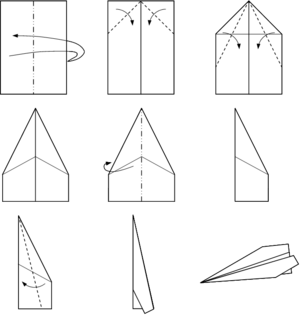Paper plane facts for kids
A paper plane is a super cool toy airplane made just from paper! People fold the paper in a special way so it can actually glide through the air. It's a bit like origami, which is the Japanese art of paper folding. Long ago, paper planes were even used to test out ideas for real airplanes! Today, making paper planes is a fun hobby and a creative craft for people of all ages.
Contents
Amazing Paper Plane Records
Did you know that paper planes can set world records? It's true!
Longest Flight Time
The record for the longest time a paper plane stayed in the air belongs to Takuo Toda. His plane flew for an incredible 27.9 seconds! That's almost half a minute.
Farthest Distance Flown
The record for the farthest distance a paper plane has flown is held by Joe Ayoob. In February 2012, his plane soared an amazing 226 feet and 10 inches (or about 69.14 meters)! A super talented person named John Collins designed the plane for him.
How Paper Planes Fly
Paper planes might seem simple, but they use the same basic ideas that help real airplanes fly!
Understanding Airflow
When you throw a paper plane, air moves over and under its wings. The shape of the wings helps create something called lift. Lift is the upward force that pushes the plane into the air.
Forces at Play
There are other forces too:
- Gravity pulls the plane down.
- Drag is the air pushing against the plane, slowing it down.
- Thrust is the force you give the plane when you throw it.
A well-designed paper plane balances these forces to glide smoothly.
Making Your Own Paper Plane
Making a paper plane is a fantastic way to learn about design and flight. There are tons of different designs, from simple dart-like planes to more complex gliders.
Simple Steps to Fold
Most paper planes start with a rectangular piece of paper. You fold it carefully, often starting with a central crease, then folding the corners and edges to create wings and a nose. Each fold changes how the plane will fly!
Experiment with Designs
Don't be afraid to try different folding techniques. Small changes to the wings, tail, or nose can make a big difference in how far or how long your plane flies. It's all about experimenting and having fun!
Images for kids
See also
 In Spanish: Avión de papel para niños
In Spanish: Avión de papel para niños





